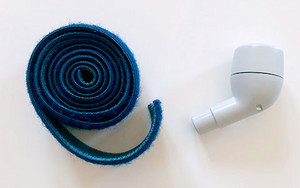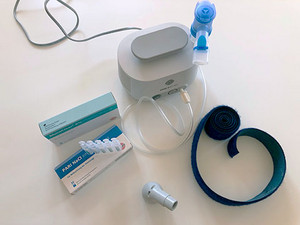Early and consistent treatment of bronchiectasis is essential to stop the dilation spreading and to stop or at least slow down progression of the lung disease. We show the treatment options respiratory physiotherapy can offer patients with bronchiectasis.
Bronchiectasis are dilations in the bronchial tubes (more on explanation, causes and definition of bronchiectasis). In the past, lung disease often went undetected, but over the last five years or so, the number of diagnoses is rising, explains respiratory physiotherapist Marlies Ziegler. She works with many bronchiectasis patients who regularly attend for treatment. An early diagnosis of bronchiectasis is important to be able to give patients the right treatment and so to keep them living as healthy and long a life as possible.
“The aim of bronchiectasis treatment is always to mobilise the secretion that collects in the diseased and dilated bronchial tubes and to transport it out of the lungs”, explains Marlies Ziegler. This is because mucus is the ideal breeding ground for bacteria and viruses, which can result in lung inflammation. This inflammation makes existing bronchiectases grow and new ones develop.
For this reason, daily bronchiectasis treatment is essential, as only this way can patients counteract the progression of the disease.
The respiratory physiotherapist speaks from experience: “The vast majority of patients with bronchiectasis inhale with a nebuliser once or twice a day to maintain the cilia epithelium and to help liquefy the mucus and transport the secretions. Saline solutions and hypertonic saline solutions are ideal, as they dissolve mucus. Many patients add medications that dilate the airways.”

Once the secretion is liquified by inhalation, it is important to transport this up within the airways to the throat so it can then be coughed up. “As well as what we call autogenous drainage, devices and aids can support respiratory physiotherapy, which, for example, vibrate to change air flow in the lungs and so set the secretion in motion. These include the oscillating PEP system PARI O-PEP, which features a ball inside the aid that oscillates as the patient exhales. These oscillations are transmitted to the bronchial tubes and loosen the mucus inside the bronchiectases. It can also be helpful to wear a chest belt when using the oscillating PEP systems. This changes the position of the chest, which in turn can help the air in the lungs move around and also affects the respiratory muscles. Changing position can also help to mobilise secretion”, explains Marlies Ziegler. PEP respiration with a PEP system without oscillation can also be helpful.

Depending on where the bronchiectases are, it can be difficult and time-consuming to mobilise the secretion. To shorten and make best use of therapy time in these cases, it is helpful to use the PARI BOY Pro. This allows patients to easily combine moist inhalation and PEP respiration by attaching to the nebuliser of the PARI BOY Pro to the PEP S-connector and so every time they exhale it is under positive expiratory pressure (PEP).
The physiotherapist also has another tip for secretions that are stubbornly lodged in the airways affected by bronchiectasis: “In these cases, it helps patients if they sit up from lying down or change position in some way. The movement sets the secretions in the lung in motion, and so they detach from the mucous membranes and are easier to cough up. Positions that help are lying on your front, side, back and a slightly head-down position. To some extent, the bronchiectases drain spontaneously when the patient changes position.” An enhanced form of positioning is exercises that open and mobilise the chest.

If the secretion is very difficult to loosen, mobilization exercises may help. “Transporting the secretions can become tricky and tough when the bronchiectasis extends far. In this case, the dilations tend to be narrow and long, which makes it particularly difficult to draw the mucus out of the furthermost corner. Here it is important to keep a close eye on the variation when the patient exhales. Mobilization, stretching and twisting positions, chest opening and other exercises which efficiently loosen the mucus from the lungs, also help.“
An article written by the PARI BLOG editorial team.
© 2025 PARI GmbH Spezialisten für effektive Inhalation